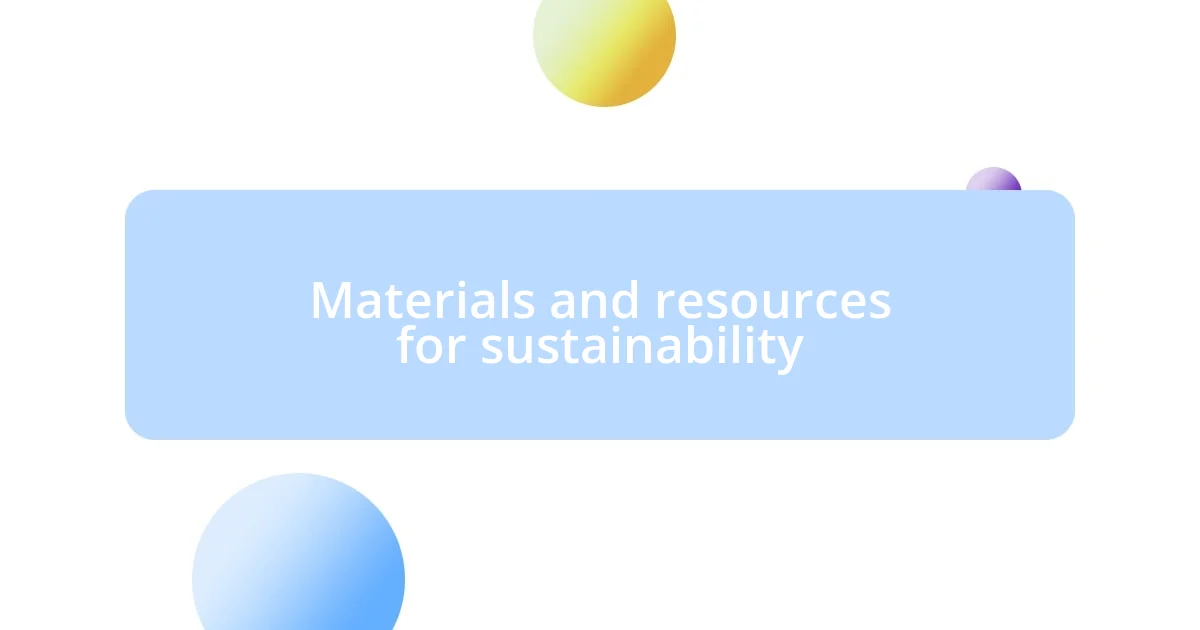Key takeaways:
- Sustainable design prioritizes renewable resources and energy efficiency, fostering long-term benefits for people and the planet.
- Emerging trends include biophilic design, circular design, and tech integration, enhancing well-being and minimizing waste.
- Measuring success in sustainable design involves both quantitative metrics (like carbon footprint) and qualitative narratives, focusing on community impact and user experiences.

Understanding sustainable design principles
Sustainable design principles revolve around the idea of creating spaces and products that harmonize with our environment rather than deplete it. When I consider a project, I often ask myself, “How can this design benefit both people and the planet?” It’s a reflective question that keeps me rooted in sustainability, ensuring I focus on long-term impacts rather than short-term gains.
One of the core principles is using renewable resources, which reminds me of a recent collaboration I had with a local architect who emphasized natural materials. Observing how he seamlessly integrated bamboo into his designs was eye-opening. Bamboo grows quickly and is incredibly durable, proving sustainable choices can lead to stunning results.
Another important principle is energy efficiency, which I believe is crucial for reducing our ecological footprint. I recall visiting an energy-efficient building that utilized passive solar design; it felt warm and inviting. It made me wonder: what if more structures embraced such principles? The potential for a greener future excites me, as I see countless opportunities for innovation in design!

Importance of sustainability in design
Sustainability in design is essential, not just for the environment but also for fostering a sense of responsibility in the design community. I sometimes think about how each design choice sends ripples through our ecosystems. For example, I remember working on a project where the client wanted to use eco-friendly paints. That choice not only improved indoor air quality but also created a more inspiring work environment. The impact of our design choices can truly resonate beyond the immediate space.
Here are some aspects that underline the importance of sustainability in design:
- Resource Conservation: Sustainable design encourages the use of materials that minimize resource waste, ensuring better preservation of the planet’s natural resources.
- Health Benefits: Incorporating non-toxic materials improves indoor air quality, which is crucial for the health and wellbeing of occupants.
- Economic Advantage: Sustainable buildings often lead to lower operational costs, reflecting that environmentally friendly choices can also be financially smart.
- Community Impact: By prioritizing sustainability, we contribute to stronger communities, fostering a shared responsibility for our environment.
- Aesthetic Value: Thoughtful, sustainable design can create beautiful spaces that are not only functional but also visually appealing, reflecting care for both people and the planet.

Emerging trends in sustainable design
Sustainable design is witnessing a shift towards biophilic design, which seeks to connect people more closely with nature. I remember a project I was involved in where we incorporated living walls and natural light in an office space. The result was astounding: staff reported feeling more energized and less stressed. Seeing this connection between environment and well-being really drives home how crucial nature is in design.
Additionally, there’s a growing emphasis on circular design, which I’ve come to appreciate for its innovative approach to product life cycles. I once attended a workshop that highlighted how companies are now designing products that can be easily disassembled for recycling or repurposing. This proactive mindset not only reduces waste but fosters creativity, challenging designers to think beyond traditional boundaries.
Finally, tech integration is a trend I find fascinating. Smart design that utilizes IoT (Internet of Things) devices is transforming how we interact with spaces. I recall visiting a smart home that adjusted lighting and temperature based on occupancy. It made me realize that technology can significantly enhance energy efficiency, paving the way for a more sustainable future.
| Trend | Description |
|---|---|
| Biophilic Design | Integrating nature into design to enhance well-being and productivity. |
| Circular Design | Creating products with reusability and recycling in mind to minimize waste. |
| Tech Integration | Utilizing smart technologies to optimize energy efficiency and improve user experience. |

Materials and resources for sustainability
When it comes to sustainable materials, I find that the choices we make can be both exciting and daunting. Recently, I had the chance to work with reclaimed wood for a residential project. It not only added a unique aesthetic to the space but also carried a story with it. Incorporating materials like this makes me think: what if every design choice we made came with a narrative? I believe that understanding the sources of our materials deepens our connection to them and underscores our responsibility.
I often reflect on the growing availability of bamboo as a sustainable alternative in design. Having installed bamboo flooring in my own home, I can personally attest to its durability and natural beauty. Plus, it’s a fast-growing resource that doesn’t compromise forests. It’s fascinating to observe how these materials foster a sense of innovation while also respecting our planet. Why aren’t more people exploring these options? They represent a harmonious blend of functionality and eco-friendliness that I hope gains more traction in the future.
Another area worth discussing is the role of lifecycle assessments in material selection. During a recent project, we carefully considered how each material would perform over time. I remember the moment when we chose recycled aluminum for the exterior facade. The thought of its durability, coupled with the fact that it could be endlessly recycled, brought a sense of satisfaction to the entire team. By moving beyond aesthetics to think about the lifecycle, aren’t we truly honoring the ethos of sustainable design? I firmly believe that prioritizing the entire lifespan of our materials will shape the future of our industry, encouraging all designers to think critically about their footprint.

Implementing sustainable practices in projects
Implementing sustainable practices in projects necessitates a thoughtful approach to each phase of design. I once participated in a community initiative where we utilized local materials to construct an eco-friendly playground. It was a rewarding experience, as we not only reduced transportation emissions but also fostered a sense of ownership among the families who would use it. I can’t help but wonder: how often do we overlook the potential of local resources in our projects?
As we integrate sustainable practices, collaboration becomes key. During a recent project, I teamed up with a group of engineers to create an energy-efficient building using renewable energy sources. What struck me was how their technical expertise beautifully complemented my design vision, showcasing the power of interdisciplinary teamwork. Have you considered how much more impactful your projects could be with diverse perspectives?
On a broader scale, a shift in mindset is essential for effective implementation. I recall attending a symposium where the speakers passionately described the importance of thinking long-term and embracing a waste-free mentality. This changed my perspective and made me question how often we resort to shortcuts. Isn’t it time we embraced the challenge of sustainable innovation? By cultivating this mindset, I believe we can redefine success in our projects, focusing not just on outcomes but the positive impacts we leave behind.

Measuring impact and success
Measuring the impact and success of sustainable design can feel like a daunting task, yet it is crucial for making informed decisions. I remember when I was part of a project that implemented a feedback loop for our designs. By actively seeking input from the community post-completion, we could evaluate not only how the space was used but also its emotional and environmental impact. It became clear to me that success isn’t just about meeting design goals; it’s about fostering a lasting relationship between the space and its users.
Quantifying sustainability can raise a lot of questions. How do we truly assess the environmental benefits of our designs? In my experience, using metrics like carbon footprint reduction and material recycling rates can provide tangible evidence of success. I once tracked the reduction in energy consumption in a building after we redesigned it with green roofs and solar panels. The decrease was invigorating; it confirmed our efforts were worthwhile and made me reflect: wouldn’t it be amazing if more designers proactively shared such results to inspire others?
Moreover, I believe storytelling plays an integral role in measuring success. Recently, I had a client share how much they valued the spaces we created for their community, which is a powerful testament to our work. It goes beyond numbers; it’s about the connections formed and the lives improved. Isn’t that a more profound way to gauge our impact? By capturing and sharing these narratives, we can inspire a cultural shift towards valuing sustainable design not just for its outcomes but for the positive change it fosters in communities.













